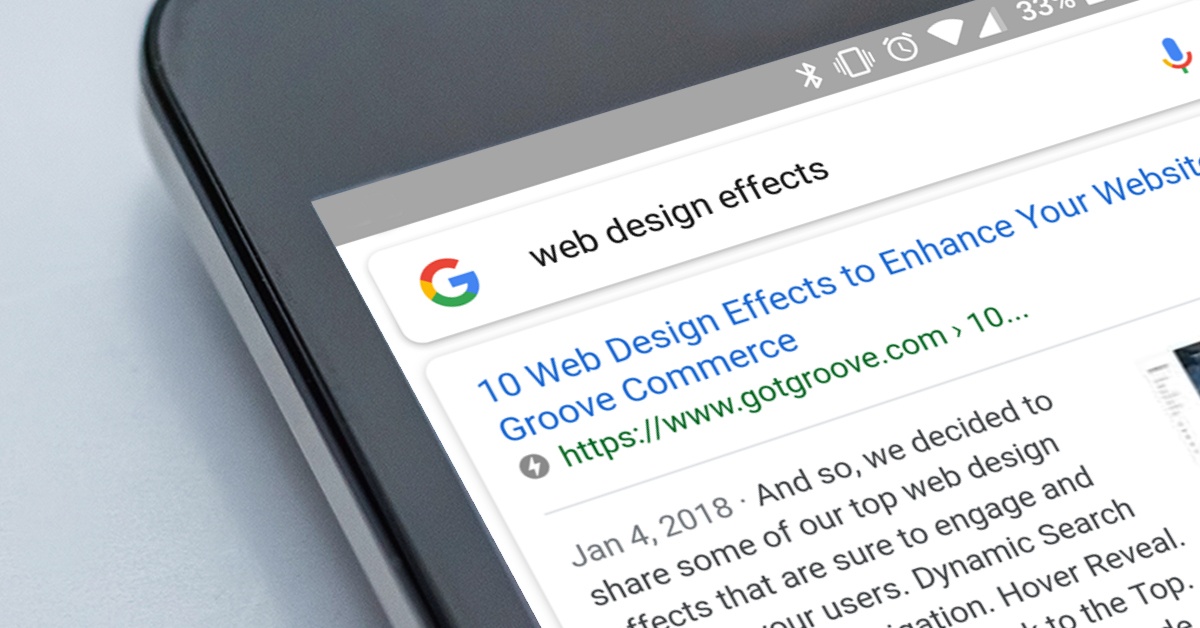With frequent algorithm changes, new search engine feature updates and conflicting advice, many e-tailers are unsure of where to start with an eCommerce SEO strategy. That’s why we’re pulling back the curtain on a few of our tried-and-true eCommerce SEO strategies that can drive serious results for your business.
When people open a website, they want the page to populate as quickly as possible. Think about how frustrating it is when you try to open a website, and it takes forever for the content to appear. If you are like most people, you will probably click right off the page. Google has reported for years that the probability of someone bouncing from your page goes up by 32% as the load time increases from 1 to 3 seconds. At the top of any list for ecommerce SEO strategies for ecommerce lies page load speed.
Since the time it takes for a website to load impacts people’s behavior, it also impacts SEO. The search engines want people to have a positive experience when making a query. Since people respond negatively to websites that take too long to load, search engines will also give negative marks to these sites. These marks impact your SEO and therefore how highly your page appears on the SERPs in response to relevant queries.
If you are interested in SEO strategies for eCommerce sites, let's look at some of the most important factors you need to know.
Testing your page load speed for eCommerce SEO strategies
Since your page load speed impacts your SEO, Google has also made it easy for you to test your website to see just how fast it loads and where potential problems might occur. PageSpeed Insights can be an excellent place to get started. All you need to do is enter your URL and the report will tell you how long it takes to load your site to various milestones. It will also offer suggestions for what you can do to fix some of the issues and see the biggest gains.
Before you take any steps to improve your page load speed, it is helpful to track your current speed so you have a benchmark and can judge the impact of your efforts moving forward.
Improving page load speed
After you have gauged your initial page load speed, you want to take steps that will improve your performance. Shaving even a second off your page load speed can help boost you in front of the competition.
Compress your images for SEO strategies for ecommerce websites
Loading images can be one of the more challenging components for browsers to open, which makes it a key area for you to optimize. With image compression, you reduce the size of the image file without necessarily disrupting the quality of the photo itself. This makes it a quick fix as a part of your ecommerce SEO strategies.
There are a number of tools available online that make it easy for you to compress your images. If you put any video files on your site, you will likely want to follow a similar process and compress the video files, as this will make it easier for the browser to load the page.
Along similar lines, you can also use a process known as lazy loading with your SEO strategies for ecommerce sites. With lay loading, you have your image files only load when that part of the screen is visible to the user. Since you can prioritize your design and which images load first, you encourage the web page to load the more important components before the images. Your users can then start interacting with your site earlier. This will boost your page load speed rankings as well.
Audit your plugins
Plugins can help you run a variety of different interesting features on your website. Unfortunately, if you have too much running it can quickly slow down your site load time.
You want to periodically take an inventory of the plugins on your site. See which ones you absolutely still need and which ones can be deactivated or deleted from your site altogether as a part of your ecommerce SEO strategies.
Use browser caching
Browser caching helps your site load faster because it reduces the number of times your site needs to make requests to external servers. The browser instead ‘remembers’ the site from the last time the user visited and it will load faster on their screen. SEO strategies for ecommerce websites will encourage you to take this step.
Building your business with eCommerce SEO strategies
Improving your site load speed can help you boost your overall site rankings and build more traffic to your website. If you have not paid much attention to your site speed in the past, it is time to get started with a site load speed test.
If you want to take your site optimization and ecommerce SEO strategies further, we can offer you an audit to determine the areas where you can make the most progress with your site speed SEO. We can help you reach your goals. Let’s see how we can build your site together.
How To Improve Your eCommerce SEO Strategy
Improve your organic search rankings and increase website traffic, brand awareness and conversion with these tips to enhance your eCommerce SEO strategy:
- Reduce load time
- Optimize for mobile
- Resolve site errors
- Enable canonical tags
- Add customer reviews
- Use markup to enable rich snippets and knowledge graphs
- Add breadcrumbs
- Optimize your content
- Optimize for site search
- Monitor your SEO visibility
1. Reduce Load Time
Fast load times aren’t just essential for a great user experience - they also significantly impact search rankings. In our experience, 100-200s of milliseconds load time is a solid benchmark.
Although there are many ways to improve site speed, image compression can typically make an immediate impact. We also recommend checking Google Tag Manager or other eCommerce SEO tools to take inventory of active scripts on your site. If the list starts to look more like a novel, you might want to remove excess calls that may be slowing down your site.
2. Optimize For Mobile
If your site isn’t mobile optimized, you’re at a serious search disadvantage. Evolving user habits make responsive design essential from both an SEO and user experience perspective.
If you’re looking to take things a step further, Google’s AMP format can further optimize mobile experiences by reducing load time and improving mobile search rank. HubSpot has a great tool called Website Grader that has Viewports configured and can check if your site is mobile responsive.
3. Resolve Site Errors
Keep your site clean by continually monitoring Google Search Console (formally known as Google Webmaster tools). Site errors may include broken links, indexed 404 pages or errors in sitemap files to name a few. Although not all errors are created equal, resolving them improves Google’s ability to index your site and can positively affect search rankings.
4. Enable Canonical Tags
Canonicalization, also known as canonical tagging, tells search engines that a page URL actually represents a default master page. This is especially useful when you have pages with more than one URL (e.g. your home page or blog listing pages).
In this example, canonical tags transfer SEO credit from duplicate URLs to the default page that you want to rank. It’s a simple but necessary fix that can have a large impact on search rankings.
HubSpot also recently unveiled a way to add canonical tags directly in the COS and blog posts, making tag implementation even easier for SEO experts and novices alike.
5. Add Customer Reviews
Search engines treat customer reviews as new website content and engagement, which are all factors that influence rankings. Improve your eCommerce SEO strategy by adding customer reviews to significantly improve the user experience by adding third-part credibility to your business.
If you’re using BigCommerce development, you have access to hundreds of apps in their app store, including our friends at Yotpo. Also be sure to utilize Schema.org language so that your product reviews, stars and number of reviews show up on search engine results pages.
6. Use Markup to Enable Rich Snippets and Knowledge Graphs
As an e-tailer, you can give search engines detailed product information to display – such as price, availability, and review ratings – right on the search page. Google and other search engines are aggressively rolling out new formats for search results.
Sites that get featured in the Rich Snippets and Knowledge Graphs are now the first place where visitors tend to click. Getting featured in this part of SERP will help attract clicks and, ultimately, more visitors to your page. Use Google’s Structured Data Testing Tool to see if your pages are properly using Schema.org markup formatting.
7. Add Breadcrumbs
Website breadcrumbs allow both Google and your customers to understand specific parent-child relationships when it comes to products and product categories. Think of it like a roadmap that makes it easier for search engines to crawl and index your site. This tried-and-true tactic can help to improve your user experience and rankings with minimal effort.
8. Optimize Your Content
This is a huge category (and a separate article all together), but I want to specifically focus on two main areas: product descriptions and category pages.
Product Descriptions
Product descriptions are often a challenge for e-tailers who sell products from manufacturers that also have an eCommerce presence. To separate yourself from competitors, focus on the psychology behind the product. Why would someone purchase this particular product? Give more than the generic details the manufacturer offers.
From an SEO perspective, think about the terms you are trying to rank for. We never encourage keyword stuffing, so spend some time researching keywords that make sense for your products and include them in places that make sense.
Category Pages
From a content perspective, treat category pages as individual home pages. By this, we mean to optimize your content (H1s, links, etc.) for the term you are trying to rank for. This will allow for a broader sense of content and increase your chances of ranking for slightly broader terms.
9. Optimize For Site Search
Although site search is not a specific SEO tactic, it is an essential website feature that affects the way customers find products. When it comes to your product pages, place keywords with high internal search volume into H1 & H2s as well as body copy and meta descriptions. This will help with your keyword focus and product placement within search engine results pages.
Bonus tip: enable Site Search feature in Google Analytics to track what your visitors are searching on your site. You can enable this feature in "View Settings" under “Site Search Settings”, then enter your search parameter query (based on the eCommerce platform you use). The search terms can later be viewed under Behavior - Site Search section in Google Analytics.
10. Monitor Your SEO Visibility
Google is known to roll out at least 2 or 3 major algorithm changes every year. The last updates prioritized mobile friendly and HTTPS protocol enabled sites.
Be sure to frequently monitor your SEO visibility via third party tools such as Searchmetrics and MOZ Site Explorer. Being proactive when it comes to organic performance can help you stay ahead of competition.
Conclusion
SEO is just one important part of the inbound marketing methodology. If you want to get familiar with eCommerce inbound marketing, read our comprehensive guide to discover easy ways to ignite your site's performance.
If you have additional questions regarding eCommerce SEO or want to improve your eCommerce SEO strategy, don't hesitate to contact us!

E-BOOK
20 Best Shopify Apps For Your eCommerce Store
Explore tags:
About the author
Subscribe to the Groove Newsletter
Get the latest updates and insights straight to your inbox



